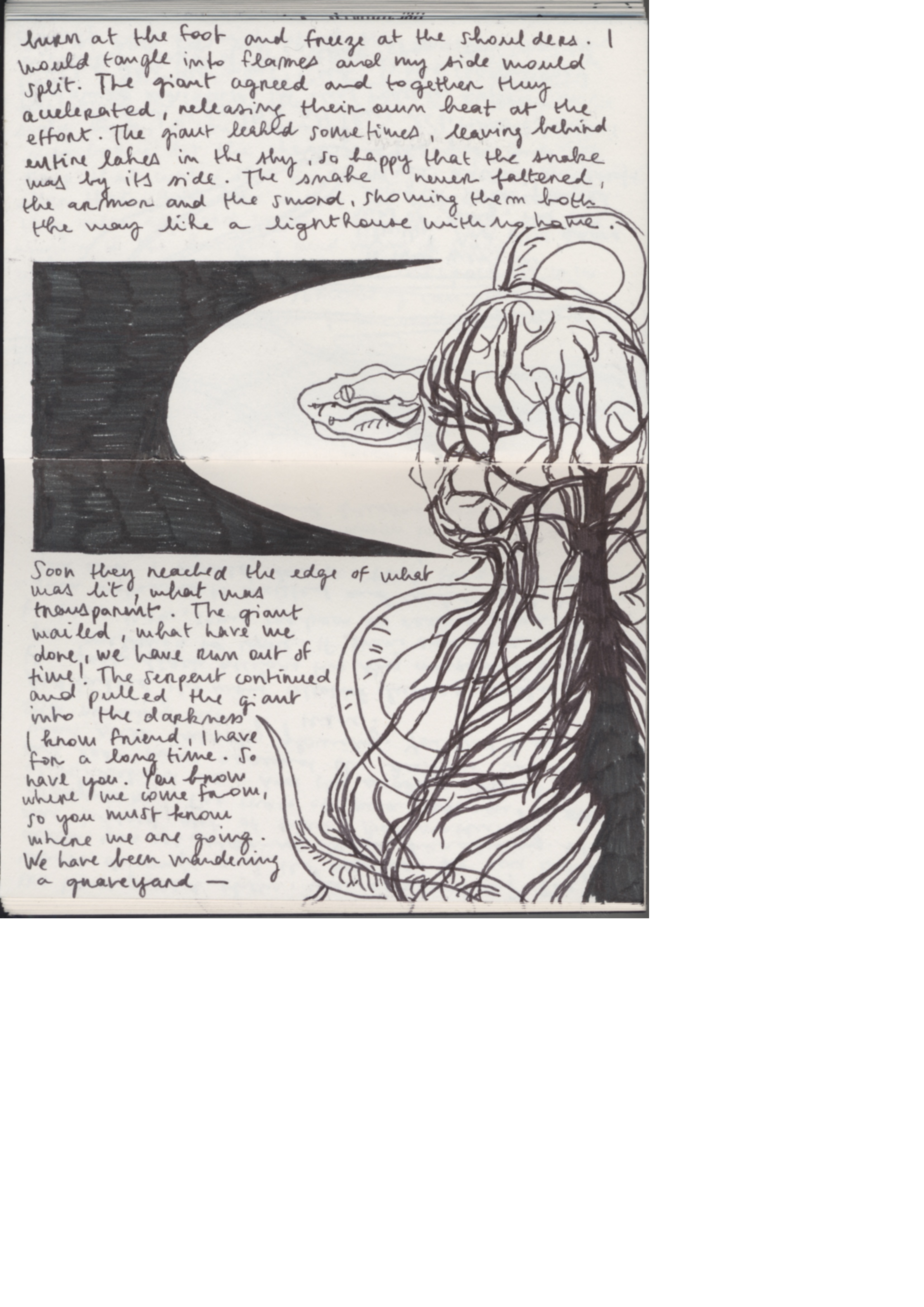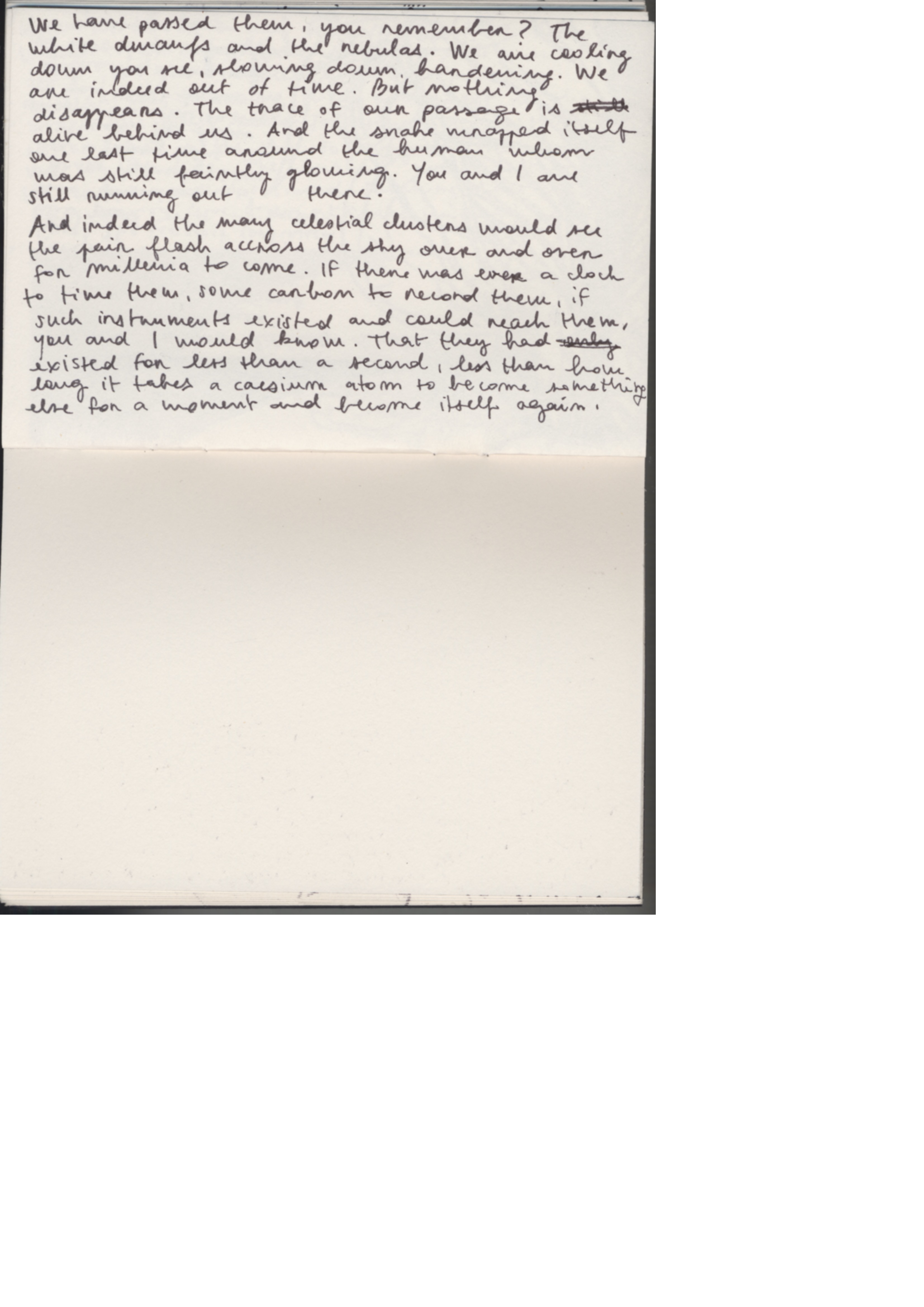
The cosmic microwave background is residual radiation from the very first time light was able to travel through space. When the universe was created in an explosion, it was so hot and so dense that no light could move through it. As it cooled down, as matter itself was created, the universe became transparent. This initial dispersion of light sent waves of radiation across the observable, expanding vacuum. Today, human radios are capable of picking up this microwave pattern, of hearing the sound of the origin, the frequency of existence.
Somewhere south of the central universal current, there began to breathe a human and a snake. Two persons capable of leaping across stars and who would both roam the observable universe for as long as each survived. They were born in a blip, almost by accident. The human was forged by lightning at the heart of the Big planet’s anticyclone. One day a terrible storm struck the atmosphere repeatedly with great electrical charge. And the wind swept up the sparks and the dust and bound them together. Crust became fibre and bright limbs of flesh stretched slowly into the night. The snake rose up and out of an unstable fog at the outermost layer of the blue planet. A rapid sequence of condensation and diffraction contracted the hexagonal pattern of the scaly skin. By chance, a thin opening in the atmosphere let the fog fluid escape. It curled in a long strip into the dark and never stopped curling after that. Both born out of the generative heat they were immediately exposed to the relentless cold and to the rhythm of the bursting and dying of stars. Warmth is the fuel of life, it cuts pockets into time, within which things can unfurl and unravel. The lifecycle of bio matter.
The snake and the human emerged and grew in their respective corners of space. Both bodies dried, hardened, like coming out of deep sticky sleep as each pair of eyes adjusted to the theater of light that surrounded them. There were so many bright shining spots, some closer than others, engulfed in a sea of darkness. At first the human thought the dark was static, opaque. That was until it was compelled to take its first step over a neighboring star. As the numbing cold settled on the skin, staying still became unbearable. The movement, excruciating at first, then addictive, revealed the iridescent shimmering that surrounded everything. Dazzling layers of translucent spectres populated the sky and at certain angles shapes appeared in them, like ghosts floating through giant oil spills. They were all moving through the darkness, in the same direction and away from one another all at once. The snake, compelled by this dance which was evidently magnetic, in the sense that it was the current itself, chased these shadows even before it could see them. It was a matter of knowing when one has had enough, a dangerous play no doubt. The snake had to remember in its trance to stay close to the stars, to know when to seek shelter in the blazing heat after a long stretch through the dark. The human, less adventurous, walked from star to star, making a deal: safety over comfort.
When the snake met the human, it was the first time either of them had come across organic kin. The human was tall now, a giant, wide with light, cables of life running through it in blue and red streaks. With every movement, tonnes of litres of water came charging through the night sky, creating great ripples in the dark fabric. Its soles were burned and blistered and fresh with crystals of ash; prey to the scorching of the active stars and the gnawing of the extinguished dead. The snake looked like a twisting beacon, skin like fiberglass weaving the darkness, starlight reverberating off it violently. It wound around and around in countless revolutions and stretched around solar systems, chasing comets. Its organs wrapped around and throughout the shards of heat and life.
The four eyes met as, for the first time, they escaped their respective solar clusters. The world became both smaller and larger in an instant. Who is to say whether imagination is fueled by experience or restrained by it? Either way, possibility became abundant. They were so different, one bent all over, the other almost liquid. And yet neither missed the sight - shining through the skin - of a heart, a pair of lungs, a digestive tract, a gall bladder and intestines all around. And suddenly solitude dawned on them. They were not simply experiencing their own versions of a universe made for them or in their image. Sharing meant something else. Solitude meant something else. Suddenly there was a witness. The shimmering apparitions in the night sky were not visions or dreams. They were weaved into the night. Who else was hiding in the dark? The pull of this question was inebriating, inescapable, a sudden throbbing in the nerves, a sturdy rhythm, as if paced by the drumming of black holes against spacetime; like the frequency of negative matter. Bearing witness - this is what created between them a companionship, or at the very least an appreciation, for one who is going in the same direction. What else was there to do than look, search for other pairs of eyes that could look back at them and recognize them and tell them about their world among the swarms of ghosts?
This game was long, the longest ever played. The human and the snake travelled all their lifetime without ever finding a neck that turned, a face that blinked. The human grew visibly tired. The charring of the stars extended from its extremities to cover the rest of its body, its veins less visible under the thickening dark crust. The snake had lost entire chunks of brittle flesh here and there slithering again and again through increasingly hotter and denser stars. Resentment also grew, a small parasite at first, easy to swat away, then a pulsating tumor, harder to ignore. The sky was still cold, the stars were still bright.
For the first time since they met the snake spoke, compelled by age and fear. Maybe even resignation, but also affection for its partner. To give them purpose the snake proposed a race. It wagered anything the human desired. Grateful and greedy the human began without a word and together they accelerated. They chased each other and time, releasing their own heat at the effort. The iridescent shapes that had taunted them all along became blurred streaks. They raced so fast they thought they might get ahead of them, finally be able to look back and see them all clearly.
Scraped and scratched by the showers of debris the human started to leak, leaving behind entire lakes in suspension. And the skins shed by the serpent, caught in the current or on some star, twisted and torn, briefly pollinated the night. If they had dared to look back they would certainly have seen things foaming at the edges of the giant pools. And as time passed the shedding became skinning, and the leaking, bleeding. Limbs opening, organs struggling to sit still, threatening to gush out.
Soon they reached the edge of what was lit, what was transparent. The human, scraps now of its former self, wailed in horror. What had they done? They had run out of time! The human looked over at the snake, steadfast, it was still curling towards the edge, flailing like the rags of a white flag. The snake’s eye was set on the human. Over time the sun had bleached the protective layer of the cornea, now scorched dry. It was bright and round and suddenly the human remembered the white dwarfs they had passed on their long long way. The snake had lost its other eye. This one, it seemed, remained only as a reminder of the desiccation of things. Of the way stars are born in an instant and spend eternities dying. The great cooling had begun and it would take longer than the very age of the universe for it to end. They were out of time. But nothing disappears. The trace of their passage is alive behind them.
And indeed the many planetary clusters and whoever inhabited them would see the pair flash across the sky over and over for millenia to come. If there was ever a clock to record them, some carbon paper to time them, if such instruments existed and could reach them, you and I would know that they had existed for less than a second, less than how long it takes a cesium atom to become something else for a moment and become itself again.





